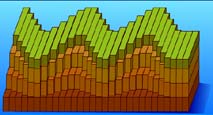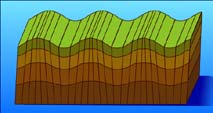Earthquakes and Man-Made Shocks Seismic Waves
 P-Wave P-Wave |
 S-Wave S-Wave |
 Love Wave Love Wave |
 Rayleigh wave Rayleigh wave |
The energy from an earthquake, explosion, or other seismic source moves through the Earth as a wave front that spreads in all directions.
There are several different kinds of seismic waves. Each type moves in a different way. The two main types of waves are body waves and surface waves. Body waves can travel through the Earth's inner layers, but surface waves can only move along the surface of the planet like ripples on water.
Body Waves
P-waves (primary or compressional waves) are the fastest moving seismic waves. They move with a push-pull motion, causing particles in the rock to move back and forth in place. As the wave moves out from the focus, the particles move together and apart along the direction that the wave is moving.
P-waves can move through solids, liquids, or gases. They are very similar to sound waves, pushing and pulling the rock just like sound waves push and pull the air. You can see the motion of a P-wave if you stretch a spring toy across a table and push one end. The energy will move along the spring, pushing and pulling like a P-wave.
S-waves (secondary, shear, sideways or transverse waves) travel much more slowly than P-waves. They do not travel through liquids. S-waves cause the particles to move from side to side. Their motion is at right angles to the direction the wave is traveling.
Wiggle the end of a rope sideways and watch the wave travel up the rope. That’s what an S-wave looks like.
Surface Waves
Love waves are named for A.E. H. Love, a British mathematician who worked out the mathematical model for this type of wave in 1911. Love waves move like a snake, shaking the ground from side to side. Although they travel slowly from the seismic source, they are very destructive. It is these waves that are most often responsible for causing buildings to collapse during an earthquake.
Rayleigh waves are named for Lord Rayleigh (John William Strutt) who mathematically predicted the existence of this type of wave in 1885. A Rayleigh wave rolls along the ground just like a wave rolls across a lake or ocean. As it rolls, it moves the ground both up and down and side to side in the same direction that the wave is moving. Most of the shaking felt during an earthquake is due to Rayleigh waves.
Although surface waves are often the most destructive, most geologists are even more interested in body waves. Since body waves travel through the earth, they can provide a lot of information about its structure. Among other things, they can help geologists locate rock layers that might contain oil, gas, and other valuable minerals.
This content has been re-published with permission from SEED. Copyright © 2025 Schlumberger Excellence in Education Development (SEED), Inc.

